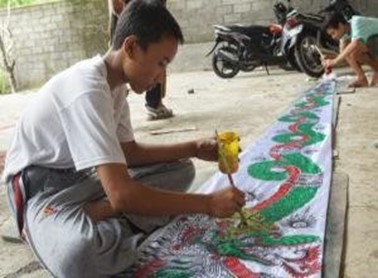Abstract
By exploiting the potential of art and culture that exists in Paksebali Village, this can be a prominent and sustainable tourist destination. The synergy between the craftsmen group and the tourism sector will not only boost the local economy, but also ensure that this rich cultural heritage is preserved and appreciated by future generations. Innovation in craft products that combines local cultural elements with modern trends. While previous research mostly deals with Although previous research mostly discussed the tourism potential in Paksebali Village, this article focuses on craftsmen who can create various types of products that are attractive to tourists, such as Endek Cloth Weaving Craft, Tedung, Prada Bludru Craft, Lontek Craft, Gambelan Bali Craft, Topeng Bali Craft. This diversification helps attract tourists who have a variety of preferences. This qualitative research was conducted in Paksebali village, Dawan Subdistrict, Klungkung Regency, Bali. Data was collected using the combination between in-depth interview and observations. The informants who participated in this research are craftsmen in Paksebali village, as my case studies. The findings show that through synergies between the craftsmen group and the tourism sector, there is a mutually beneficial exchange of value. Tourists gain experience and quality products, while the craftsmen gain the opportunity to increase their income and expand their market. In addition to economic benefits, these collaborations also have an impact on the preservation of local culture. Craftsmen products often reflect the history, tradition, and identity of a region. With increasing tourist interest in these products, the group of craftsmen is encouraged to continue to preserve and develop their expertise. Craftsmen in Paksebali Village can help increase the village's attractiveness as a tourist destination, while maintaining and preserving local cultural heritage. It is recommended that Craftsmen in Paksebali Village is expected to improve quality and innovation in craft products, setting up a craft centre or gallery, working with tourism agencies, conducting digital marketing and promotion, improving the packaging of craft products to make them more attractive, actively participating in exhibitions and festivals as well as cultural preservation and education.
References
Adi, R. (2021). Metodologi Penelitian Sosial dan Hukum. Jakarta: Yayasan Pustaka Obor Indonesia.
Ainiyah, R., Burhan, S., Ardiansyah, M. F., & Fidanti, D. P. (2021). Pengembangan Desa Digital Sebagai Upaya Mengangkat Potensi Lokal Desa Karangrejo, 2(2):1-18, https://journal.ummat.ac.id/index.php/JADM/article/view/5999, accessed on 1 May 2023.
Dewi, M. H. U. (2013). Pengembangan Desa Wisata Berbasis Partisipasi Masyarakat Lokal di Desa Wisata Jatiluwih Tabanan, Bali, Jurnal Kawistara, 3(2):129–139, https://doi.org/10.22146/kawistara.3976, accessed on 2 May 2023.
Dewi, R.P. (2022). Analysis of Art Culture Potential and Tourism Village Development in Gegesik Kulon Village, Cirebon Regency. International Journal of Social Science, 2(3), 1755–1762. https://doi.org/10.53625/ijss.v2i3.3648, accessed on 2 May 2023.
Hammersley, M. (2019). Ethics of Ethnography. In: Iphofen, R. (eds) Handbook of Research Ethics and Scientific Integrity, https://doi.org/10.1007/978-3-319- 76040-7_50-1, accessed on 27 June 2024.
Kadek, N. & Diantari, Y. (2022). Estetika Postmodern Pada Produk Fast Fashion dengan Kain Bermotif Endek, 146–168, https://ebookchapter.isi-dps.ac.id/index.php/dcd/article/view/61, accessed on 3 June 2023.
Karakul, Ö. (2019). The Effects of Tourism on Traditional Craftsmanship for The Sustainable Development of Historic Environments, European Journal of Sustainable Development, 8(4):380-390, https://doi.org/10.14207/ejsd.2019.v8n4p380, accessed on 23 may 2024.
Kriyantono, R. (2020). Teknik Praktis Riset Komunikasi Kuantitatif dan Kualitatif Disertai Contoh Praktis Skripsi, Tesis, dan Disertai Riset Media, Public Relations, Advertising, Komunikasi Organisasi, Komunikasi Pemasaran. Rawamangun: Prenadamedia Group.
Lestari, P. F. K., Astakoni, I. M. P., & Ida Bagus Swaputra (2020). Peningkatan Daya Saing Produk Tedung Bali Menembus Pasar Ekspor, Paradharma: Jurnal Aplikasi IPTEK, 3(2): 135–141. https://jurnal.undhirabali.ac.id/index.php/para_dharma/article/view/1049, accessed on 28 April 2023.
Miles, M.B.; Huberman, A.M.; dan Saldana, J. (2014). Qualitatif Data Analysis: Methods of Source Book (third edition). London: Publikasi SAGE, Inc.
Prami, A. A. I. N. D. & Widiastuti, N. P. (2023). Peran Perempuan dan Kesetaraan Gender pada Sektor Ekonomi Kreatif di Desa Paksebali, Jurnal Ilmu Sosial dan Humaniora, 12(1):140–148, https://doi.org/10.23887/jish.v12i1.54857, accessed on 10 June 2024.
Putri, C. F., & Syamwil, R. (2022). Peranan Perajin Batik Dalam Pengembangan Industri Pariwisata Di Kota/Kabupaten Kendal. Fashion and Fashion Education Journal, 11(2):69–72, https://doi.org/10.15294/ffej.v11i2.15548, accessed on 23 June 2024
Ramadiartha, I. G. M. & Erli, K. D. M. (2018). Strategi Pengembangan Industri Tenun Endek Melalui Pendekatan One Village One Product di Kecamatan Sidemen Kabupaten Karangasem, Jurnal Teknik ITS, 7(2):2–7, https://doi.org/10.12962/j23373539.v7i2.36796, accessed on 3 June 2023.
Safira, D. M. A. I., Mahardika, G., & Hartaka, I. M. (2023). Eksistensi Tradisi Lukat Geni Di Desa Paksebali Kecamatan Dawan Kabupaten Klungkung. Vidya Darsan: Jurnal Mahasiswa Filsafat Hindu, 4(1), 95-101. https://jurnal.stahnmpukuturan.ac.id/index.php/darsan/article/view/2681, accessed on 23 June 2024.
Setem, W. & Mudana, I. W. (2021). Penyusunan Ensiklopedia Bidang Seni Lukis Klasik, Seni Ukir, Dan Tekstil Di Bali, Brikolase : Jurnal Kajian Teori, Praktik Dan Wacana Seni Budaya Rupa, 13(2):22–42, https://doi.org/10.33153/brikolase.v13i2.3763, accessed on 2 May 2023.
Soeswoyo, D. M.; Jeneetica, M.; Dewi, L., Dewantara, M. H.; & Asparini, P. S. (2021). Tourism Potential and Strategy to Develop Competitive Rural Tourism in Indonesia, International Journal of Applied Sciences in Tourism and Events, 5(2):131–141, https://doi.org/10.31940/ijaste.v5i2.131-141, accessed on 23 June 2024.
Sukarini, N. W., Beratha, N. L. S., & Rajeg, I. M. (2019). Industrialisasi Seni Kriya Di Desa Mas, Gianyar. Mudra Jurnal Seni Budaya, 34(1), 45-52. https://doi.org/10.31091/mudra.v34i1.634, accessed on 23 June 2024.
Suryani, I.; Sair, A.; & Syarifuddin, S. (2022). Kehidupan sosial ekonomi pengrajin di Desa Tanjung Atap Kecamatan Batu tahun 2007-2018. Agastya: Jurnal Sejarah Dan Pembelajarannya, 12(2):169-180, https://doi.org/10.25273/ajsp.v12i2.8332, accessed on 1 May 2023
Tanzeh, A. (2011). Metodologi Penelitian Praktis. Yogyakarta: Teras.
Telagawathi, N. L. W. S. (2014). Inovasi pemasaran dan penciptaan pasar kain Tenun Endek di Kabupaten Klungkung. In Seminar Nasional Riset Inovatif II (pp. 875-890). https://www.scribd.com/document/498955326/341-37-434-1-10-20171123, accessed on 23 June 2024.
Wardani, N. A., & Nurbaiti, D. (2021). Analisis Pemberdayaan Kelompok Masyarakat Melalui Usaha Kerajinan Tangan Berbasis Ekonomi Kreatif Oleh Yayasan Dreamdelion (Studi Kasus Di Rusun Pinus Elok Jakarta Timur). JAMBIS: Jurnal Administrasi Bisnis, 1(4), 338-349. https://ojs.stiami.ac.id/index.php/JUMABI/article/view/2318 accessed on 23 June 2024.

This work is licensed under a Creative Commons Attribution-NonCommercial-ShareAlike 4.0 International License.
Copyright (c) 2024 ETNOSIA : Jurnal Etnografi Indonesia





